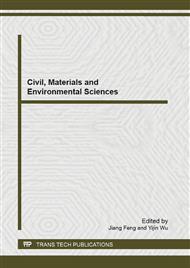p.284
p.290
p.300
p.304
p.310
p.317
p.323
p.327
p.331
Effects of Different Micro-Catchment Mulching Methods on Water Consumption and Requirement Law of Corn Field
Abstract:
The study the effect of unary or binary mulching micro-catchment models including plastic film-mulching ridge and ditch plantation (T1), plastic film-mulching ridge and ditch film-mulching plantation (T2) and plastic film-mulching ridge and ditch straw mulching plantation (T3) on was carried out in allusion to the critical issue of the severe lack of water resource in the western Liaoning province of China, in comparison with traditional cropping patterns. The water-holding effect of T2 under the condition of this experiment is the best, followed by T3 and T1. During corn growth stage, through respective comparison, the water is less consumed by 49.87 mm, 43.06 mm and 29.39 mm. In the meantime, the micro-catchment could reduce the water requirement of the crop. Through respective comparison, T2, T3 and T1 reduce water requirement by 81.66 mm, 69.20 mm and 48.45 mm during the growth stage. The average crop coefficient the growth stage is respectively reduced by 0.12,0.16 and 0.09 compared to that under the traditional model. The corn yield and water use efficiency (WUE) is increased to a different extent through various catchment plantation cultivation models and traditional plantation model. Especially, it is increased substantially by T3 and T2.
Info:
Periodical:
Pages:
310-316
Citation:
Online since:
August 2013
Authors:
Price:
Сopyright:
© 2013 Trans Tech Publications Ltd. All Rights Reserved
Share:
Citation:


